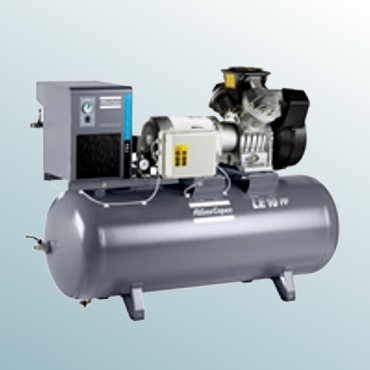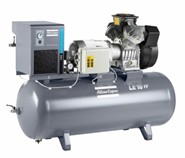Portfolio

Piston compressors series RKE / RKA
The piston compressors have been specially developed for industrial applications. Powerful, durable and reliable.
The compressors are available in different versions:
- as add-on unit
- various container variants
- Sonic hood variants
 |
 |
 |
Features of our industrial series
- direct drive
- max. operating pressure 10/15/20/30
- Motor power 1.5 to 7.5 kW
- Volume flow rate 150 to 850 l/min
- E-motor in protection class 1P55 with insulation class F
- maintenance-free direct drive
- very well suited as an auxiliary unit for peak consumption
- star triangle switch from 4 kW rated motor power
- Pressure switch, pressure gauge, safety valve, ball valve for container version
- also available as base frame version
Quality
The RKA RKE series meets the highest quality requirements in terms of service life and reliability. This series has been tried and tested for a long time and has proven itself over decades. For smaller air volumes and constant start-stop operation, you will find the ideal piston compressor here.
For optimal design of the compressor we need the following data from you
Specified application, flow rate in l/min, pressure in bar, noise level
Piston compressors for industrial applications
Most people probably think of a piston compressor when they think of a compressor. Perhaps you already know the two basic principles of air compression. One of these principles is displacement compression. There are a variety of compressor types that are classified as positive displacement compressors. The oil-lubricated or oil-free piston compressor is one of them.
What are piston compressors?
The piston compressor is the oldest and most frequently used industrial compressor. It is available as single-acting or double-acting as well as oil-lubricated or oil-free compressor, with different numbers of cylinders in different configurations. With the exception of very small compressors with vertical cylinders, the V configuration is the most common variant for small compressors. For double-acting, large compressors, the L configuration with a vertical low-pressure cylinder and a horizontal high-pressure cylinder offers enormous advantages and is the most common design.
Oil-lubricated compressors usually work with splash lubrication or pressure lubrication. Most compressors have self-acting valves. A self-acting valve opens and closes due to pressure differences between both sides of the valve disc. The piston compressor compresses the air/gas by means of a piston which compresses it in a sealed housing and then releases it in a specific direction for specific purposes. Control is provided by one or more crank drives if the system is a multi-piston compression system. The work of the pistons is cyclic. The volume flows of a reciprocating compressor are rather low, but they generate high pressures. What are oil-free piston compressors? Oil-free piston compressors have piston rings made of PTFE or carbon, and alternatively the piston and the cylinder wall can be profiled (serrated), as with labyrinth compressors. Larger machines are equipped with a crosshead and seals on the piston pins and a vented intermediate piece to prevent oil from the crankcase from entering the compression chamber. Smaller compressors often have a crankcase with permanently sealed bearings.
Pulsation damping
Piston compressors generate a pulsating volume flow due to their special mode of operation. These pressure fluctuations can possibly impair the function of various compressed air receivers. Especially control circuits and measuring devices react sensitively to a pulsating volume flow. Compressed air tanks counteract this phenomenon - due to the way the piston compressor works - by smoothing out the pressure fluctuations.
Condensate separation
The air heats up due to the compression taking place in the compressor. Warm air has a higher water absorption capacity than cool air. The warm and water-enriched air is usually transported with the volume flow into the compressed air tank. In the compressed air tank the heated air finally cools down so that the water absorption capacity decreases and the condensate collects in the compressed air tank. There it should be discharged via a suitable condensate separator. Compressed air tanks that are only emptied irregularly can corrode due to the condensate. A protection against corrosion is the full bath galvanizing of the compressed air tank. If the condensate is drained regularly, it is not absolutely necessary to galvanise the tank. Zinc plating is also suitable if the condensate contains a high concentration of aggressive components.
About Rico
Rico Compressed air plant was founded in 1945 and today is a system solutions provider for pressurized air. Our product range includes air production, processing, distribution and of course an excellent service.


